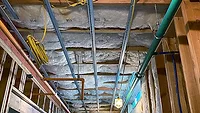Plumbing Trends
Turning The Offbeat Into The Mainstream
Electronic faucet technology, once limited to airport and restaurant bathrooms, is beginning to make the transition to the home front. At last year's Kitchen/Bath Industry Show, for example, Delta Faucet Co. launched e-Flow, an electronic faucet line designed specifically for residential use.
We wanted to know more about how the company envisioned the market and, maybe more importantly, the marketing for this product.
"Remember the resistance we all once felt to using automatic teller machines?" asks Charlie McTargett, Delta's director of product development. "How about personal computers and cell phones? Over time, consumers learned to understand the features and appreciate the benefits these products offered. We predict the same type of education and adoption process for electronic faucets."
While McTargett primarily discussed residential electronics, many of his thoughts may also apply to selling homeowners on products that are somewhat "out of the ordinary." And "out of the ordinary" can be a very generous term, too. See if any of McTargett's thoughtss can apply to more than just electronic faucets.
Identifying three groups of potential customers was the first marketing step McTargett outlined:
Universal design components include no-step entrances, wider doorways and hallways to accommodate wheelchair access, as well as wall reinforcements installed in and around toilet and bathing fixtures for grab bar installations. In some instances, accessible housing regulations are part of multihousing building codes enforced by the Department of Housing and Urban Development (codes vary by local jurisdiction).
Today, universal design has a broader focus: To create living spaces with knowledge of and sensitivity to people of all ages and abilities -- making life easier for everyone in the home. Also known as "lifespan design" or "transgenerational design," this all-encompassing design aesthetic takes into consideration the specific needs of various life stages. Many single-family home builders have proactively embraced universal design, winning fans among discerning homebuyers -- not just people with disabilities -- who see their homes as long-term residences for family members young and old.
An electronic faucet can be especially useful in households with small children. Temperature controls reduce the risk of accidental scalding, and the auto turn-off prevents flooding. And, its novelty factor may actually encourage kids to wash their hands, brush their teeth and complete otherwise tedious tasks. The active adult market, comprised of baby boomers maturing into their 50s, presents two distinct marketing opportunities: an aging population that will demand universal design features, and burgeoning empty-nester homebuyers who want smaller, yet smarter living spaces.
Not deterred but actually fascinated by new technology, they're likely well versed in MP3 players (digital music players/libraries) and PDAs (personal digital assistants). These are the people who asked Santa for the Microsoft X-Box or Mac iPod for the holidays last December.
To these gadget gurus, the fact that the e-Flow is the first-of-its-kind is a selling point. Beyond coveting the latest "toys for grown-ups," these consumers also are interested in how things work -- and would likely appreciate the technology behind a residential electronic faucet.
If you've ever wondered why the same color palettes seem to appear on clothes, towels, paint, wallpaper, toys, computers and cars -- it's no accident. CMG inter-industry members range from Sherwin-Williams and Hasbro to Apple and Nike.
Master baths and powder rooms are two frequently remodeled rooms, and style seekers are frequent remodelers -- always on the look out for fashion-forward colors and designs. Consultation with CMG, along with additional trend spotting, helped Delta select finish and color options for the e-Flow that complement other fixtures and accessories on the market, to provide a coordinated look for any bathroom in the home.
"Once you understand a customer's wants and needs, you'll know which product features, functions and benefits are important to them," McTargett adds. "Over time, many home electronics may well transform from 'nice-to-have' to 'necessary' in our everyday lives and lifestyles."
Looking for a reprint of this article?
From high-res PDFs to custom plaques, order your copy today!






